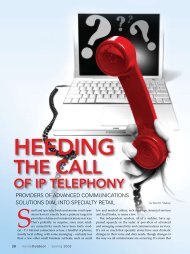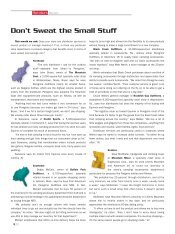Summer - InsideOutdoor Magazine
Summer - InsideOutdoor Magazine
Summer - InsideOutdoor Magazine
You also want an ePaper? Increase the reach of your titles
YUMPU automatically turns print PDFs into web optimized ePapers that Google loves.
Wireless in the U.S., December 2006<br />
Topic<br />
Statistic<br />
Wireless Subscribers at Year-End 2006<br />
Wireless Penetration<br />
Wireless-Only Households<br />
Wireless Providers<br />
233 million U.S. Subscribers<br />
More than 76 percent of total U.S. population<br />
12.8 percent of U.S. Households<br />
About 160 facilities-based carriers<br />
Monthly SMS Messages 18.7 billion messages in the month of December 2006, up 92% from 9.7 billion messages in December 2005<br />
Six Month SMS Messages 93.8 billion SMS messages during the latter six months of 2006, up 93% from 48 billion in the second six months of 2005<br />
Wireless Data Revenues $8.7 billion for the latter six months of 2006, up 82% from $4.8 billion in the latter half of 200.<br />
Source: CTIA<br />
six months of last year, 93.8 billion SMS messages crossed U.S.<br />
networks, a 93 percent jump year over year.<br />
Recent surveys of instant messaging users by AOL found that<br />
more than one-third of respondents send mobile instant messages<br />
or text messages from their cell phones at least once a week.<br />
This is a dramatic increase from 2004, when just 19 percent said<br />
they did so, and 2003, when the figure was 10 percent.<br />
A large part of text messaging’s rapid ascent can be attributed<br />
to the fact that most cell phone users aren’t required to<br />
upgrade a device, sign up for a new plan, significantly change<br />
behavior or download any type of software or application in<br />
order to adopt the service.<br />
The same thing cannot be said for most new or emerging communications<br />
or consumer technologies. But already more than 90<br />
percent of the mobile phones currently in the hands of users, for<br />
example, came pre-installed with full SMS capabilities.<br />
And the recent release of the iPhone, along with its wave of<br />
imitators, is expected to usher in a new stage in the way mobile<br />
services are viewed and used.<br />
TEXT FRESH<br />
At the same time, e-mail usage is flattening, even declining,<br />
many surveys suggest, and e-mail read and click-through rates<br />
aren’t fairing any better, says e-marketing services provider<br />
eROI. Citing increased use of anti-spam and filtering software<br />
and “images off” default settings in e-mail clients, eROI expects<br />
read and click rates to continue to slide moving forward.<br />
E-Mail Click-Through Rate (% of respondents)<br />
All respondents<br />
Store-based<br />
merchants<br />
Catalog<br />
Virtual<br />
Merchant<br />
1-2.5% 10.3% 12.1% 11.9% 9.1% 6.1%<br />
There’s no question that e-mail is losing some flavor<br />
with younger consumers, who increasingly prefer IM, social<br />
networking sites and SMS for keeping in contact with friends<br />
and social contacts. E-mail, on the other hand, is viewed as a<br />
tool for working or a way to keep up with distant relatives.<br />
In 2004, 89 percent of online teens responding to the Pew<br />
Internet & American Life Project sent or received an e-mail. By<br />
2007, a Yankee Group survey revealed that e-mailing was still<br />
the top online activity among teens, but only 80 percent of respondents<br />
sent or received an e-mail.<br />
And by the way, as much as 94 percent of text messages are<br />
read, while average SMS response rates are about 18 percent,<br />
says Kelley. E-mail read rates currently tend to hover around 20<br />
percent, while response rates tend to range between 2 percent<br />
and 5 percent, suggest eROI figures.<br />
Think of it this way. For lots of folks, in about a decade’s<br />
time, e-mail has gone from a must-have “productivity-enhancing<br />
tool,” complete with its own cute “You got mail,” catch<br />
phrase, to being perceived by many as a “time sink,” or a chore,<br />
loaded with spam and threats of viruses. “Cleaning out my<br />
inbox” today is uttered with the same enthusiasm as dusting<br />
shelves or vacuuming the floor.<br />
Text messaging, on the other hand, is fast and fresh and onthe-go,<br />
and people still get excited when they receive one, and<br />
those positive emotions and connotations are precisely what<br />
one wants attached to their marketing efforts.<br />
Consumer<br />
Brand Mfg<br />
2.51-5% 23% 15.5% 32.2% 22.1% 24.2%<br />
5.1-10% 19.2% 17.2% 16.9% 20% 24.2%<br />
10.1-15% 9.6% 5.2% 10.2% 11.4% 9.1%<br />
15.1-25% 8.2% 8.6% 13..6% 6.4% 6.1%<br />
19.1-25% 12.8% 13.8% 19.0% 10.8% 9.1%<br />
>25% 8.9% 17.2% 5.1% 6.4% 12.1%<br />
Don’t know 20.8% 24.2% 10.2% 24.7% 18.2%<br />
Source: Internet Retailer<br />
24 | <strong>InsideOutdoor</strong> | <strong>Summer</strong> 2007<br />
KNOW YOUR AUDIENCE<br />
That’s not to say that mobile messaging<br />
campaigns necessarily are right for every retailer’s<br />
customer base right now. Clearly, text<br />
messaging usage, as well as use of most mobile<br />
applications beyond voice calling, currently<br />
skews heavily toward younger users, namely<br />
those ranging from junior high up to thirtysomething.<br />
Among teens specifically, use of<br />
mobile data applications across the board is<br />
nearly double that of adults, according to analysts<br />
at Yankee Group.<br />
That partly explains the success Moosejaw<br />
is having with SMS. Wolfe admits his customer<br />
base probably is a bit younger than the industry

















